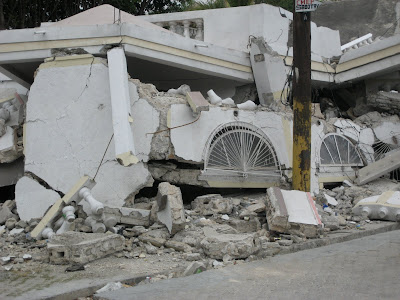The clinic was pretty basic - a couple of treatment rooms with beds (like the beds that are in your doctor's office), a pharmacy area, and an outdoor waiting area. This is the waiting area.

The pharmacy. There was a ton of stuff in it, and we spent a lot of time trying to get it organized.

Seeing patients in the hallway...trying to be efficient!

This little guy was really really sick when he first came in - totally limp and not moving much because he was so dehydrated. We put an IV in him and gave him some fluids and some antibiotics. He came back a couple of times to get more fluids and antibiotics, and by day three he looked great - interactive, playful, and pretty much back to normal.

One of the things that I really didn't expect in Chambrun was how much of an impact the earthquake would have had on people's lives. Chambrun doesn't have a lot of infrastructure, and most of the buildings are single story and made of mud bricks with an aluminum roof. Hardly any (if any at all) collapsed during the earthquake. I knew they would have felt the earthquake, but I really didn't expect it to be so central to their lives since there wasn't the physical reminder of collapsed buildings everywhere you looked.
However, I found it interesting that many of their health problems were referenced to the earthquake. Again and again, people would come in, tell me their complaint, and when I asked how long it had been going on for, the answer was usually "since the earthquake." This was especially true for people with headaches, abdominal pain, and trouble sleeping.
One lady brought her three kids to the clinic, and when I asked what was wrong, she told me that the baby is having trouble walking (the baby was about 18 months old). I asked how long the baby had been having trouble walking for, and the standard reply came back - since the earthquake. So I asked why the baby was having trouble walking, and she told me that the baby was scared of the ground shaking and was scared to walk. The baby looked in pretty good shape, and eventually I saw the baby stand and take some steps, so I knew that there must be more to the story. The translator and I did a bit more questioning, and we found out that the real concern was that the mother was widowed, had lost her mother in the earthquake, and was now unable to provide food for her kids and they were hungry.
My interaction with this lady made me a bit sad...here she is, trying the best she can to get help for her kids after experiencing such huge personal loss, spends all day waiting in line to see us after walking who know how far with three kids, and we couldn't really do much for her other than give her kids some basic medications and connect her with the local pastor. This was the case with many families that we met. To me, she was also a clear example of the earthquake's far reaching effects - she didn't live in a tent camp, yet she had been hugely affected by the earthquake and had similar needs to those that did live in the camps. She and many other people that I met in Chambrun reminded me the importance of making sure that support continues to be offered to those who are in need in all parts of Haiti, not just those in Port-au-Prince.
Thanks for reading! Next up...mobile clinics in the tent camps...











